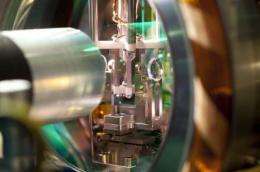Efficient and tunable interface for quantum networks

(Phys.org) -- Quantum computers may someday revolutionize the information world. But in order for quantum computers at distant locations to communicate with one another, they have to be linked together in a network. While several building blocks for a quantum computer have already been successfully tested in the laboratory, a network requires one additonal component: a reliable interface between computers and information channels. In the current issue of the journal Nature, physicists at the University of Innsbruck report the construction of an efficient and tunable interface for quantum networks.
Quantum technologies promise to redefine the landscape of information processing and communication. We already live in an information age, in which vast amounts of data are sent around the world over optical fibers, but future quantum networks may be many times more powerful. These networks will require interfaces that can transfer information from quantum processors onto light particles (photons). Such interfaces will allow optical fibers to transmit information-bearing photons between remote data registers, which are likely to be composed of quantum dots or ions. In contrast to classical information, quantum information can't be copied without being corrupted. Instead, physicists around the world are searching for ways to transfer quantum information between matter and light using entanglement, the quantum property in which the state of one particle depends on the state of a second. Now, a research team led by Rainer Blatt, Tracy Northup, and Andreas Stute at the University of Innsbruck's Institute for Experimental Physics has demonstrated the first interface between a single ion and a single photon that is both efficient and freely tunable.
The Innsbruck physicists trap a single calcium ion in a so-called Paul trap and place it between two highly reflective mirrors. They excite the ion with a laser, thereby generating a photon which is entangled with the ion and which is reflected back and forth between the mirrors. Custom tuning of the entanglement between ion and photon is possible by adjusting the frequency and amplitude of the laser. This technique has two significant advantages over previous approaches that have entangled atoms with light: "The efficiency with which we produce entangled photons is quite high and in principle could be increased to over 99 percent," explains Northup. "But above all, what this setup lets us do is generate any possible entangled state." To this end, the frequency and amplitude of the laser light are carefully chosen so that target collective state of the ion and photon is reached. At the core of the experiment lies an optical resonator consisting of two highly reflective mirrors. Photons bounce back and forth up to 25,000 times between these mirrors, interacting with the ion, before escaping through one mirror into an optical fiber. "Along with an efficient entanglement process, we've demonstrated an entangled quantum state between an atom and a photon with the highest precision measured to date," explains Andreas Stute.
The experiment offers important insights into the interaction of light and matter and may prove useful in constructing quantum computers or a future quantum internet. "Whenever we have to transfer quantum information from processing sites to communication channels, and vice versa, we're going to need an interface between light and matter," explains Northup.
The researchers are supported by the Austrian Science Fund and the European Union. Their results appear in the May 24 issue of Nature.
More information: Tunable Ion-Photon Entanglement in an Optical Cavity. A. Stute, B. Casabone, P. Schindler, T. Monz, P. O. Schmidt, B. Brandstätter, T. E. Northup, R. Blatt. Nature 2012. DOI: 10.1038/nature11120
Journal information: Nature
Provided by University of Innsbruck




















